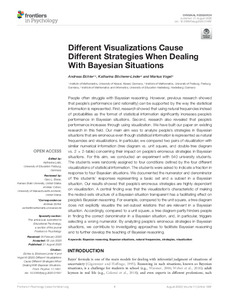| dc.date.accessioned | 2020-09-14T15:41:13Z | |
| dc.date.available | 2020-09-14T15:41:13Z | |
| dc.date.issued | 2020-08-21 | |
| dc.identifier | doi:10.17170/kobra-202009111790 | |
| dc.identifier.uri | http://hdl.handle.net/123456789/11814 | |
| dc.description.sponsorship | Gefördert durch den Publikationsfonds der Universität Kassel | ger |
| dc.language.iso | eng | eng |
| dc.rights | Namensnennung 4.0 International | * |
| dc.rights.uri | http://creativecommons.org/licenses/by/4.0/ | * |
| dc.subject | Bayesian reasoning | eng |
| dc.subject | Bayesian situations | eng |
| dc.subject | natural frequencies | eng |
| dc.subject | strategies | eng |
| dc.subject | visualization | eng |
| dc.subject.ddc | 500 | |
| dc.title | Different Visualizations Cause Different Strategies When Dealing With Bayesian Situations | eng |
| dc.type | Aufsatz | |
| dcterms.abstract | People often struggle with Bayesian reasoning. However, previous research showed that people’s performance (and rationality) can be supported by the way the statistical information is represented. First, research showed that using natural frequencies instead of probabilities as the format of statistical information significantly increases people’s performance in Bayesian situations. Second, research also revealed that people’s performance increases through using visualization. We have built our paper on existing research in this field. Our main aim was to analyze people’s strategies in Bayesian situations that are erroneous even though statistical information is represented as natural frequencies and visualizations. In particular, we compared two pairs of visualization with similar numerical information (tree diagram vs. unit square, and double-tree diagram vs. 2 × 2-table) concerning their impact on people’s erroneous strategies in Bayesian situations. For this aim, we conducted an experiment with 540 university students. The students were randomly assigned to four conditions defined by the four different visualizations of statistical information. The students were asked to indicate a fraction in response to four Bayesian situations. We documented the numerator and denominator of the students’ responses representing a basic set and a subset in a Bayesian situation. Our results showed that people’s erroneous strategies are highly dependent on visualization. A central finding was that the visualization’s characteristic of making the nested-sets structure of a Bayesian situation transparent has a facilitating effect on people’s Bayesian reasoning. For example, compared to the unit square, a tree diagram does not explicitly visualize the set-subset relations that are relevant in a Bayesian situation. Accordingly, compared to a unit square, a tree diagram partly hinders people in finding the correct denominator in a Bayesian situation, and, in particular, triggers selecting a wrong numerator. By analyzing people’s erroneous strategies in Bayesian situations, we contribute to investigating approaches to facilitate Bayesian reasoning and to further develop the teaching of Bayesian reasoning. | eng |
| dcterms.accessRights | open access | |
| dcterms.creator | Eichler, Andreas | |
| dcterms.creator | Böcherer-Linder, Katharina | |
| dcterms.creator | Vogel, Markus | |
| dc.relation.doi | doi:10.3389/fpsyg.2020.01897 | |
| dc.subject.swd | Bayes-Verfahren | ger |
| dc.subject.swd | Eigenfrequenz | ger |
| dc.subject.swd | Strategie | ger |
| dc.subject.swd | Visualisierung | ger |
| dc.type.version | publishedVersion | |
| dcterms.source.identifier | EISSN 1664-1078 | |
| dcterms.source.journal | Frontiers in Psychology | eng |
| dcterms.source.pageinfo | Article 1897 | |
| dcterms.source.volume | Volume 11 | |
| kup.iskup | false | |


